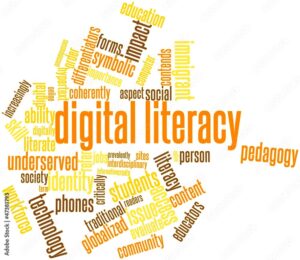 In my view, technology has not necessarily resulted in a more equitable society. However, it has significantly enhanced access to information and education. During the debate, the pro side argued that technology has led to a more equitable society because of its ability to provide access to education and medical services. Additionally, technology allows individuals who are unable to attend classes in person to participate in learning opportunities. However, as the opposing side discussed, this has its limitations. Limited access to technological tools, affordability challenges, and insufficient digital literacy present significant barriers that restrict the capabilities of medical professionals in providing telehealth services, as well as those trying to access education and information. A few classmates considered how these disparities became increasingly evident during the COVID pandemic, clearly highlighting differences in access to technology among students. Furthermore, inequalities in the access to the latest technology may intensify existing social status differences. Katia’s comment regarding the complexity and multiple facets of this issue is a very important argument. Providing universal access to the internet and technology is unlikely to address all challenges. Fixing these problems requires more than just throwing money at it. A complete plan that focuses on the underlying issues is crucial, and while money is necessary for implementation, it alone does not resolve the main problem.
In my view, technology has not necessarily resulted in a more equitable society. However, it has significantly enhanced access to information and education. During the debate, the pro side argued that technology has led to a more equitable society because of its ability to provide access to education and medical services. Additionally, technology allows individuals who are unable to attend classes in person to participate in learning opportunities. However, as the opposing side discussed, this has its limitations. Limited access to technological tools, affordability challenges, and insufficient digital literacy present significant barriers that restrict the capabilities of medical professionals in providing telehealth services, as well as those trying to access education and information. A few classmates considered how these disparities became increasingly evident during the COVID pandemic, clearly highlighting differences in access to technology among students. Furthermore, inequalities in the access to the latest technology may intensify existing social status differences. Katia’s comment regarding the complexity and multiple facets of this issue is a very important argument. Providing universal access to the internet and technology is unlikely to address all challenges. Fixing these problems requires more than just throwing money at it. A complete plan that focuses on the underlying issues is crucial, and while money is necessary for implementation, it alone does not resolve the main problem.
 Technology offers numerous advantages in supporting individuals with various disabilities, including those related to speech, hearing, and physical abilities, as highlighted in the article Digital Technology Is A Game Changer For Education Worldwide. Assistive technology offers benefits such as better communication, stronger numeracy skills, increased academic engagement, and greater social inclusion. It provides access to education for children regardless of their location or abilities. In the article, 6 Ways the New National Education Technology Plan Could Help Close Achievement Gap, Duncan stated “if the technology revolution only happens for families that already have money and education, then it’s not really a revolution.” This statement highlights reasons why it may not be accurate to claim that technology has resulted in a more equitable society. Technology has it advantages, but disparities remain. Until these disparities are addressed, technology will still benefit some individuals more than others in society. Another key point highlighted in the article is the importance for teacher training to support the transition toward integrating technology effectively into classroom practices.
Technology offers numerous advantages in supporting individuals with various disabilities, including those related to speech, hearing, and physical abilities, as highlighted in the article Digital Technology Is A Game Changer For Education Worldwide. Assistive technology offers benefits such as better communication, stronger numeracy skills, increased academic engagement, and greater social inclusion. It provides access to education for children regardless of their location or abilities. In the article, 6 Ways the New National Education Technology Plan Could Help Close Achievement Gap, Duncan stated “if the technology revolution only happens for families that already have money and education, then it’s not really a revolution.” This statement highlights reasons why it may not be accurate to claim that technology has resulted in a more equitable society. Technology has it advantages, but disparities remain. Until these disparities are addressed, technology will still benefit some individuals more than others in society. Another key point highlighted in the article is the importance for teacher training to support the transition toward integrating technology effectively into classroom practices.
 Digital inclusion, ensuring that everyone has access to technology, is essential if technology will ever lead to a more equitable society. However, it is essential not only that individuals have access to the technology, but also that they possess the skills required to use it effectively. In the blog, The Impact of Digital Inclusion on Social Equity, they also reiterate Katia’s sentiments that “the influence of digital inclusion on social equity is significant and complex.” Technology influences various aspects of our lives, including education, healthcare, and employment. The discussion in their blog highlights that pre-existing societal inequalities are often exacerbated by the digital divide, disproportionately impacting marginalized groups. They highlight the importance of implementing programs designed to reduce the divide, such as providing affordable internet access. They examine the extent to which internet access and digital skills can impact employment opportunities and participation in training programs. Based on my professional experience, all positions at our organizations are posted online, and a certain level of digital literacy is required to perform the job effectively. While many of us have internet access and technology, it is easy to overlook that a digital divide still exists in Canada. Even in developed countries, older adults with limited digital literacy, people from low-income backgrounds who cannot afford technology, and individuals living in rural regions without reliable internet access illustrate the existence of a digital divide.
Digital inclusion, ensuring that everyone has access to technology, is essential if technology will ever lead to a more equitable society. However, it is essential not only that individuals have access to the technology, but also that they possess the skills required to use it effectively. In the blog, The Impact of Digital Inclusion on Social Equity, they also reiterate Katia’s sentiments that “the influence of digital inclusion on social equity is significant and complex.” Technology influences various aspects of our lives, including education, healthcare, and employment. The discussion in their blog highlights that pre-existing societal inequalities are often exacerbated by the digital divide, disproportionately impacting marginalized groups. They highlight the importance of implementing programs designed to reduce the divide, such as providing affordable internet access. They examine the extent to which internet access and digital skills can impact employment opportunities and participation in training programs. Based on my professional experience, all positions at our organizations are posted online, and a certain level of digital literacy is required to perform the job effectively. While many of us have internet access and technology, it is easy to overlook that a digital divide still exists in Canada. Even in developed countries, older adults with limited digital literacy, people from low-income backgrounds who cannot afford technology, and individuals living in rural regions without reliable internet access illustrate the existence of a digital divide.
As mentioned in a previous blog post, the completion of my master’s degree would not have been possible without the support of technology. Not living in a larger centre with a university, technology has provided me an equal opportunity to access education. According to Annie Murphy Paul, the digital divide affects those who are already part of disadvantaged groups not individuals with adequate resources to access and use technology. In her blog, she discusses how children from different socioeconomic backgrounds use technology in different ways, a concept referred to as the digital Matthew Effect. Children with greater initial resources tend to gain more benefits from technology compared to those with fewer resources. Additionally, schools serving underprivileged students are often more likely to use technology for drill like activities rather than fostering engagement through creative projects. She states,
If every child has a computer, every child is starting off on equal footing. But though the sameness of the hardware may feel satisfyingly fair, it is superficial. A computer in the hands of a disadvantaged child is in an important sense not the same thing as a computer in the hands of a child of privilege.
This highlights that achieving equity involves more complexity than simply providing technology to everyone, equal access does not necessarily result in equitable outcomes. This argument was highlighted by the opposing group during the debate, and I believe it was convincing. Providing universal access to the internet and technology would promote equality, but true equity requires addressing individual needs beyond equal distribution of resources. If this digital divide is going to be reduced we need large digital companies and policymakers to address these issues.

Hi Jenna!
Thank you for such a well-written post! I like how you chose to focus on how each of your topics indicates an enhancement in society, but not necessarily equity. Jillian & Danielle brought up a great point during the debate that connects with your ideas, and it is that technology has created a more equitable society for the privileged. The digital divide, which, as you mentioned, does not refer to just having access to technology but also digital literacy skills and training, is one of the key factors in determining if equity will ever be reached. Do you know of any ways that your school, or other schools that you know of, have gone about trying to bridge the digital divide among students?
Hi Daegan,
Thank you for your question. In my role within Human Resources, my primary responsibilities involve working with staff and instructors, which means I am not directly involved in the daily efforts to address the digital divide. However, your question has sparked my interest in how they address the digital divide.
Jenna
Great read, Jenna! I’ve read multiple blog posts on this topic, and each time I have a new takeaway — yours has me thinking about how we can use technology to share information about the digital divide that exists in society. More than just using social media for doom scrolling and keeping in touch with family/friends, we can use it to shine a light on the divide and hopefully inspire change somewhere in the future.
Your conclusion offered a well-reasoned and thoughtful reflection on a number of the topics that we have covered in this class. I especially liked how you articulated the somewhat complicated and nuanced nature of the relationship between technology and equity, particularly in terms of how a focus on access is not necessarily equitable in and of itself. I also found your example of the digital Matthew Effect to be very compelling in terms of demonstrating how the use of technology can often widen gaps without appropriate supports and scaffolds.
Your mention of a focus on digital literacy and training, as well as policy-based solutions, rather than just an infrastructure-based approach to issues of equity was also particularly poignant and an important reminder of how more nuanced systemic factors need to be addressed.
In what ways do you think schools and educators take a more active role in closing the digital divide while also continuing to work towards a productive balance with technology?
Nofisat
Hi Nofisat,
You raise an important point, and I wish I had a definitive answer. However, fostering awareness and engaging in these conversations is an essential first step. It is easy to overlook the extent to which the digital divide persists, but continued discussion helps ensure it remains a priority.
Jenna